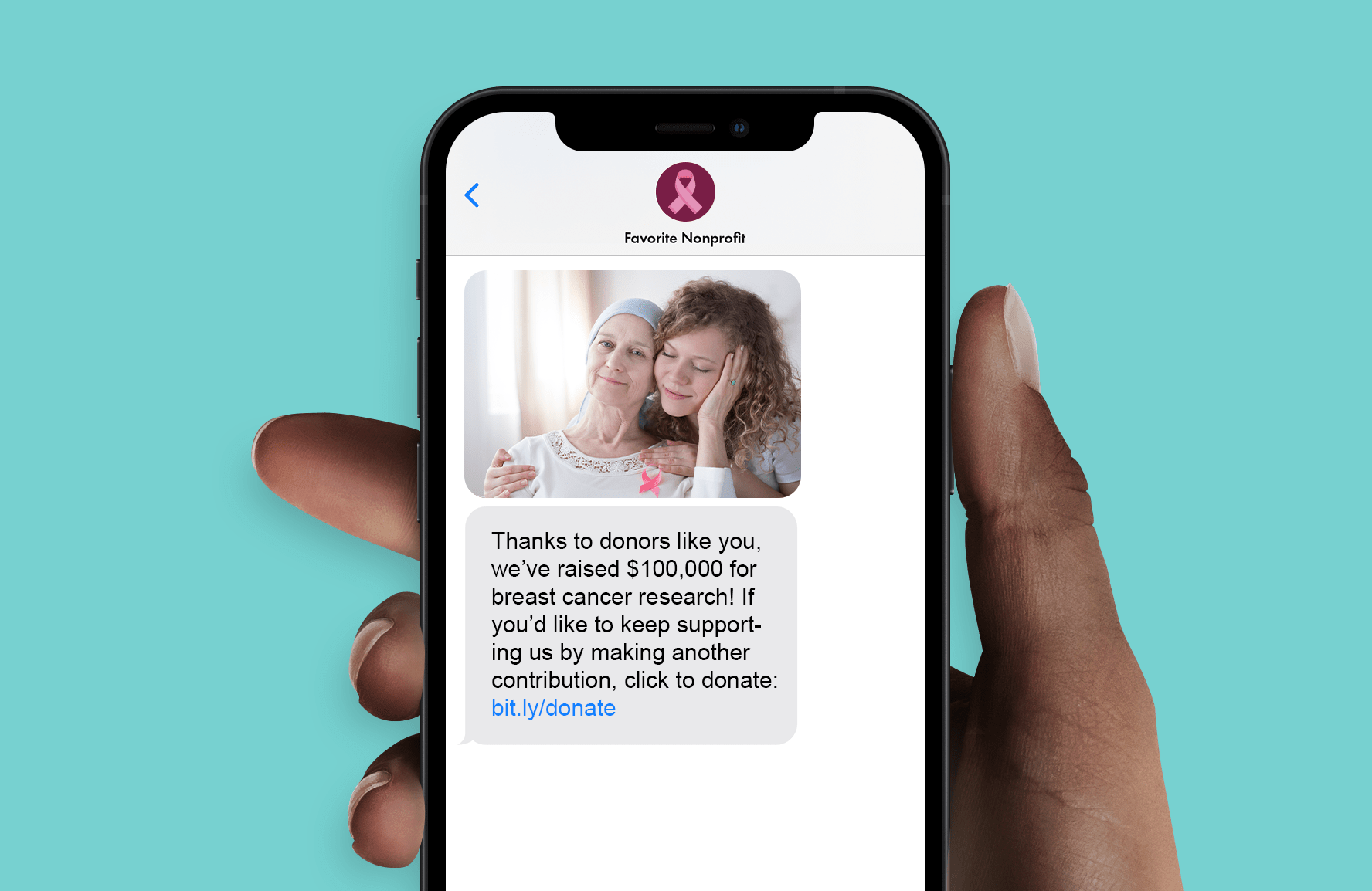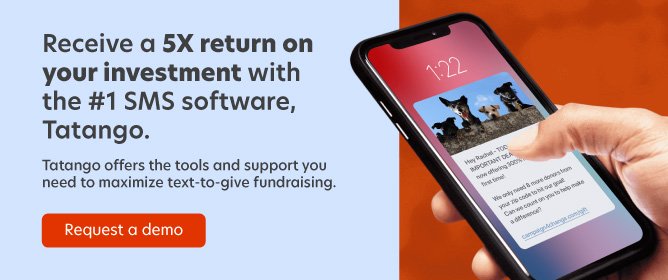 Did you know that the average person checks their phone 58 times a day? Since your donors are constantly texting, calling, or scrolling through their social media feeds, why not take these opportunities to raise more revenue and spread awareness for your mission?
Did you know that the average person checks their phone 58 times a day? Since your donors are constantly texting, calling, or scrolling through their social media feeds, why not take these opportunities to raise more revenue and spread awareness for your mission?
By incorporating text-to-give into your nonprofit’s fundraising strategy, you can meet supporters where they are and encourage them to give right from their mobile devices. In this guide, we’ll cover everything you need to know to run a successful text-to-give campaign, including:
- Text-to-Give Fundraising FAQs
- Benefits and Challenges of Text-to-Give
- Text-to-Give Statistics
- How to Set Up Text-to-Give
- Text-to-Give Fundraising Best Practices
- Tatango: The Top Platform for Text-to-Give
Meeting your fundraising goals doesn’t have to be challenging. With a robust text-to-give strategy, you can make donating to your nonprofit convenient, easy, and highly rewarding, leading to more donations down the line.
Text-to-Give Fundraising FAQs
Before we dive into how to get started with text-to-give fundraising, let’s make sure you have the basics down. These FAQs will help you understand how to effectively leverage text-to-give.
What is text-to-give?
Text-to-give, also known as text-to-donate, is a fundraising method that enables supporters to donate to your nonprofit from their mobile devices. Instead of having to power on the nearest computer or send a donation by mail, donating via text-to-give is a simple and efficient process.
How does text-to-give work?
While the exact text-to-give process may vary depending on the software you use, it will generally follow these steps:
- You promote your text-to-give campaigns and share donation appeals that include text-to-give instructions.
- Donors send a keyword to a dedicated phone number set up by your nonprofit.
- Your nonprofit sends updates and engaging messages to get to know your supporters and relate to their interests.
- Donors receive a link to your nonprofit’s mobile-friendly donation page.
- From there, donors can quickly fill out your donation form and submit their intended giving amount and billing information.
Your nonprofit can use text-to-donate year-round to send updates about your projects and campaigns, highlight the impact of donations, and establish a reliable revenue stream. Or, you can pair text-to-give with existing fundraisers by adding a mobile giving component to an auction or to a fundraising gala to ramp up donations.
What is text-to-give vs. text-to-donate?
While many nonprofits use text-to-give and text-to-donate interchangeably, depending on your service provider, there may be a few nuances to keep in mind.
Traditionally, text-to-give involves donors texting a keyword to a short code assigned to your nonprofit. In doing so, they’ll automatically donate a set amount, such as $10, which gets charged to their phone bill. While this method allows donors to support your nonprofit without entering their payment information, they have no control over their donation amount. Plus, wireless carriers often take a percentage of contributions.
So, how does text-to-donate work? Donors text a keyword to your nonprofit’s number, receive engagement messages related to your mission, and ultimately get a mobile-responsive link to the donation page. There, supporters can read about their potential impact, decide how much they want to give to your organization, and choose a preferred payment method.
The takeaway: Since you’ll often see text-to-give and text-to-donate used synonymously, don’t get too bogged down in the specific terminology. Instead, focus on finding a provider that offers your nonprofit and donors as much flexibility as possible.
For example, Tatango allows you to create a custom keyword with a shortcode (e.g., 34-567) or a 10-digit long-code, send mobile-friendly links to your donation page or volunteer sign-up form, segment your audience for personalized engagement, and learn from your SMS data with robust insights and analytics.
What kinds of organizations use text-to-give?
Nonprofits in a variety of sectors can benefit from adding text-to-give to their fundraising strategy. These include:
- Environmental conservation organizations raising funds to save ecosystems.
- Health organizations that focus on causes like medical research or humanitarian aid.
- Animal welfare organizations like local animal shelters or international wildlife conservation nonprofits.
Since text-to-give is a convenient and fast way to reach supporters, this fundraising tool is especially helpful for nonprofits that need to raise funds quickly to serve their communities.
Is text-to-give secure?
Whenever you tap into a new fundraising channel, it’s critical that you take every step to protect your donors’ private information and ensure that their funds can safely be transferred to your nonprofit. You can safeguard your data by working with a text-to-give provider with the following security features:
- SOC-2 compliance: SOC-2 refers to a security framework that maintains the privacy of your donors’ data. This means that all information stored by your text-to-give software will be protected from unauthorized access, cybersecurity leaks, and other vulnerabilities. As a result, your organization will benefit from enhanced donor trust, leading to increased giving.
- Two-factor authentication: Think of two-factor authentication as a second line of defense against hackers after your password. When you attempt to log in with your username and password, you’ll also have to type in a special code sent to your mobile phone. This extra step just takes a few more seconds and is an effective obstacle against unauthorized users logging into your account and accessing your data.
- Secure sending: Secure sending requires a user to re-enter your password before they can send out any text messages from your account. This is another layer of protection, ensuring that the text messages your recipients receive have been properly vetted and were intended to be sent out.
- Automated logout: If you’re logged into your text message provider on your computer or mobile device but haven’t had any activity in a while, you’ll automatically be logged out so your account is protected from any unauthorized users.
The right text-to-give partner checks these boxes and more so you can rest assured that your text messaging campaign adheres to all best practices.
Benefits and Challenges of Text-to-Give
When used strategically, text-to-give can significantly advance your nonprofit’s fundraising and communication efforts. However, like all fundraising channels, that doesn’t mean that there aren’t any challenges. Let’s explore some of the top benefits and challenges to keep in mind as you consider adding text-to-give to your fundraising agenda.

Benefits
With so many fundraising options available to nonprofits, you may be wondering what sets text-to-give apart. There are many benefits to using this flexible giving option:
- It’s convenient for donors. Text-to-give allows donors to give anywhere, at any time from their mobile devices. This flexibility can quickly drive traffic to your donation page. In fact, the majority of nonprofit web traffic comes from mobile users, and mobile users make up roughly 33% of donation transactions. By setting up a user-friendly giving option, you’ll be rewarded with a boost in revenue.
- It can help expand your nonprofit’s reach. 97% of Americans own a cell phone, so your nonprofit can readily grow its reach by targeting mobile users. Plus, it’s a pretty safe bet that donors who sign up to receive your texts will open them and take the intended next action of giving. Text messages have a 99% open rate and 90% read rate within just three minutes of sending, which is far superior to other popular communication modes like email, which only has a 20% open rate. Your nonprofit can leverage text-to-give to build brand visibility and help new supporters learn about your organization’s mission.
- It can be paired with any fundraising event. From peer-to-peer fundraisers like a walk-a-thon to virtual concerts, text-to-give can serve as an additional fundraising source to support any event. Simply promote your nonprofit’s text-to-give option during the event so people can give more towards your cause.
- It requires little effort on your nonprofit’s end. With the right text-to-give software, your nonprofit can send texts to thousands of people at a time, reminding recipients to give to your fundraising campaign or event. You can even segment these texts for certain audiences to make your donation requests specific and relevant. Plus, you can use your platform to automate thank-you messages for supporters once they’ve given, ensuring that every donor feels appreciated.
If your nonprofit is looking to strengthen its fundraising strategy, then text-to-give is the right option for you. Well-designed text-to-give campaigns can take your nonprofit to new heights when it comes to engaging donors and forming strong connections.
Challenges
Text-to-give can come with challenges if you don’t have a concrete fundraising strategy in place or the right tools in your toolkit. These include:
- Learning curve to using new software: Just like with any new fundraising tool, expect that it may take some time for your staff to familiarize themselves with your software’s features, capabilities, and best practices. However, the right text messaging provider will guide you through the onboarding process by providing training on campaign setup and launch, compliance, short code provisioning, and software testing.
- Compliance concerns: Your nonprofit must closely adhere to the Telephone Consumer Protection Act (TCPA), governed by the Federal Communications Commission (FCC). This can feel overwhelming, especially since even minor violations can cost your nonprofit fines and potentially affect your reputation. Work with a text messaging provider that is well-versed in all relevant policies and experienced in helping thousands of nonprofits run compliant text messaging campaigns.
- Digital fatigue from overstimulation: Your donors spend plenty of time on their phones all day—receiving requests from friends and other brands. It can be difficult to capture their attention if you don’t have the right content strategies in place. By sending personalized messages at the right time, incorporating high-value images, and emotionally appealing to your supporters, you can successfully draw their eye and direct them to give.
You can easily overcome these obstacles by constructing a well-thought-out strategy and using comprehensive text fundraising software that is designed to make getting started with text-to-give (and sustaining your campaigns) a breeze.
Text-to-Give Statistics to Keep on Your Radar
Text-to-give is a multi-faceted solution that can help your nonprofit maximize engagement and giving. This data will show the necessity of adopting text-to-give into your fundraising plan:
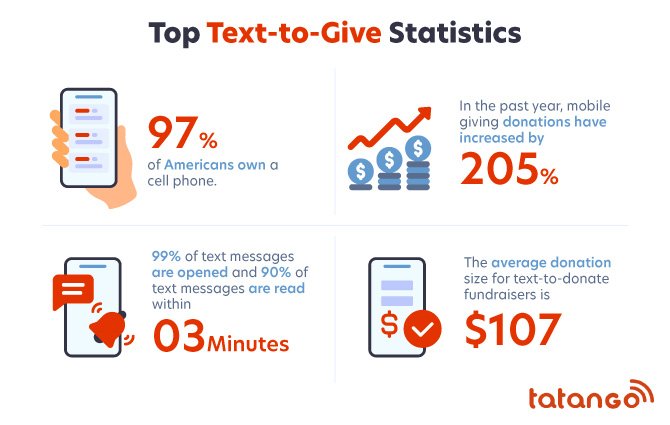
Your supporters are just a text away.
- The vast majority of Americans – 97% – now own a cellphone.
- Of these individuals, the number of Americans who own a smartphone is now 85%.
- Across the world, it’s estimated that there are 6.92 billion smartphone users, totaling 86.29% of the global population.
Mobile giving is on the rise.
- In the past year, mobile giving donations have increased by 205%.
- 25% of donors complete their donations on mobile devices.
- Nonprofits can increase their donations by 126% on average by making the donation process mobile-friendly.
Expect sizable gifts for your cause.
- The average donation size for text-to-donate fundraisers is $107.
- The average mobile donation pledge for fundraising events is $167.
- With the right text messaging provider, you can expect a $5 return in donations for every dollar spent on SMS text messaging.
Your text-to-give messages will be seen.
- 99% of text messages are opened and 90% of text messages are read within 3 minutes of being sent.
- 78% of users report that SMS messaging is the quickest way to reach them.
- SMS response rates are 45%.
These statistics illustrate the impact text-to-give can have in pushing your nonprofit’s strategic plan forward. If you’re ready to unlock your nonprofit’s full potential and hit the ground running with text-to-give, take a look at how you can set up text-to-give for your organization.
How to Set Up Text-to-Give For Your Nonprofit
Text-to-give is a simple and convenient process, for your donors and for your nonprofit’s team to set up and execute. Let’s dive into how you can kickstart text-to-give fundraising.
1. Invest in text-to-give software.
Choose a provider that can help your organization promote its fundraisers and spread awareness for its mission. The right software should come with the following capabilities:
- Automation: Easily send off welcome texts for new contacts as soon as they opt-in and thank-you messages to your text-to-give donors right after giving.
- Segmentation: Segment your contact list by donation amount, donation recency, donation frequency, demographics, location, and any other relevant factors.
- Fast message speeds: Your organization should be able to send up to 7 million messages per hour or about 2,000 per second. This way, you can reach supporters quickly with progress updates and donation requests, which is especially helpful when working under tight deadlines.
- Security: Leverage a secure, PCI-compliant text-to-give provider to safeguard your donors’ private information and protect your data from being hacked by unauthorized users.
- Data reporting: Track metrics for each text message to assess your performance, including open rate, click-through rate, number of donations, average donation amount, and total donations raised.
- Integrations with other fundraising tools: Your software should connect with other solutions already in your toolkit to create a two-way flow of data, including your CRM and marketing platform.
- Customer support: Your team shouldn’t have to navigate text-to-give alone. Look for a text-to-give provider that will support you every step of the way to fundraising success.
While investing in text-to-give software may seem like a large expense upfront, the right solution will help you earn back your money and maximize your earnings for years to come.
2. Choose a simple and memorable keyword.
Your text-to-give provider will assign your nonprofit a 5-digit shortcode (ex: 23456) or 10-digit long-code (10DLC), and you will create a keyword. Your keyword should be brief and relevant to your nonprofit’s fundraising campaign.
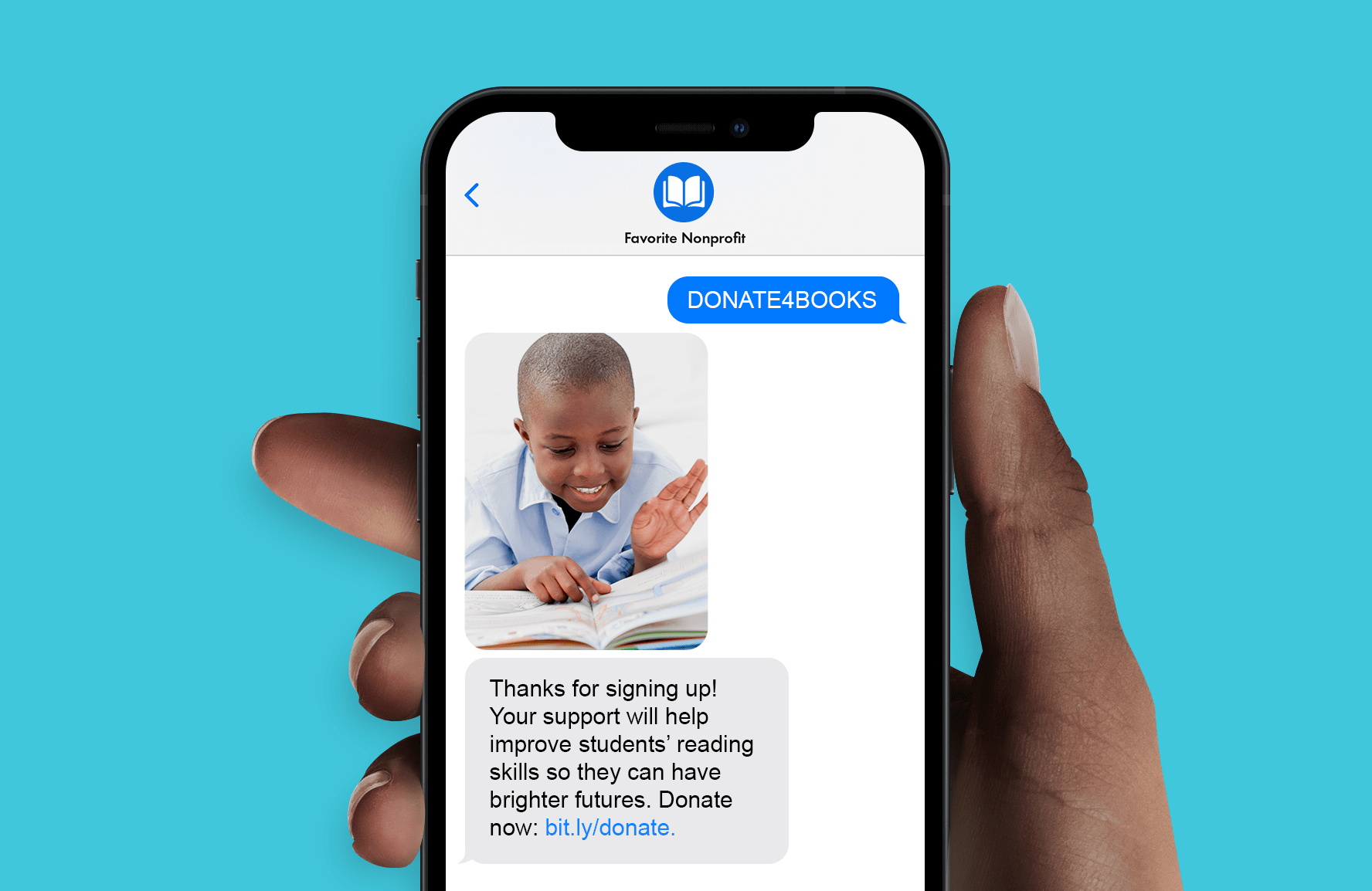
For example, if you’re a literary organization raising funds for new books your keyword could be “DONATE4BOOKS.” Donors are more likely to type in a short and catchy keyword correctly on the first try, saving them time and keeping the donation process as convenient as possible. We’ll cover keyword best practices in depth in the next section.
To opt-in to your texts, supporters will simply text the keyword to your shortcode or long-code. This easy step will set them up to receive all incoming messages from your nonprofit.
3. Grow your contact list.
To get the ball rolling on your text-to-give campaign, you need to build up a sizable contact list. Leverage these best practices to increase your subscriptions:
- Use multichannel marketing to get the word out about your text-to-give fundraiser. Tap into channels like social media, your website, email, and direct mail to increase touchpoints. We’ll discuss how you can use these channels to your advantage later on!
- Add a phone number field to your donation form and event registration forms where supporters can consent to opt-in to texts.
- Ask well-connected supporters to serve as ambassadors of your cause and promote your SMS campaign to their friends and family members.
- Offer opt-in incentives like discounted event tickets, early access to information, or other special offers related to your nonprofit’s mission.
The more supporters you’re able to reach, the more donations you can earn down the line. Using your text-to-give software, you can proactively monitor the number of subscribers you earn as well as any unsubscribers.
4. Build solid relationships.
Once supporters opt-in to your texts, you don’t want to bombard them right away with a donation request! This can easily turn supporters off and cause them to ignore your text altogether.
Instead, strategically steward your supporters and ease into your ask by first sending updates about your nonprofit, information on upcoming events, educational texts about the important work you’re doing in the community, and more.
You should also take the opportunity to get to know your subscribers better by sending out a survey asking about their interests. Using this information, you can tailor your messages to their specific preferences and philanthropic interests, making it more likely that they’ll see and engage with your messages.
5. Send tailored donation requests.
Once you’ve solidified relationships with new subscribers, you’re ready to send out a donation request. However, rather than sending every supporter a generic ask for $15, for example, you should tailor your ask to the individual to increase the likelihood of them acting on it.
For instance, let’s say a supporter who joins your SMS campaign has a history of consistently giving around $25 each year to your nonprofit. Instead of asking them for a donation of $5 or $10, which is way under what they’re willing to give, you might request that they bump up their donation to $35. This is a reasonable ask based on their donation history and challenges them to give more so your nonprofit can increase its impact.
6. Receive donations to fuel your mission.
Donors will fill out your donation form with their specific donation amount, billing information, and contact information. Your donation page should have limited prompts that ask for only the most essential information so donors can complete the form easily and quickly.
Remember that if you’re seeing a dip in donations or engagement, you can always adjust your strategies and change up the content of your messages or the frequency at which they’re being sent. The right text-to-give software will even allow your nonprofit to perform A/B testing so you can compare two or more variations of a text message to assess which is more effective.
Text-to-Give Fundraising Best Practices
By setting aside ample time to prepare, your text-to-give fundraiser can meet and exceed your fundraising goals. Explore these best practices so you can leverage your text-to-give platform to produce exceptional fundraising results.
1. Choose a relevant text-to-donate keyword.
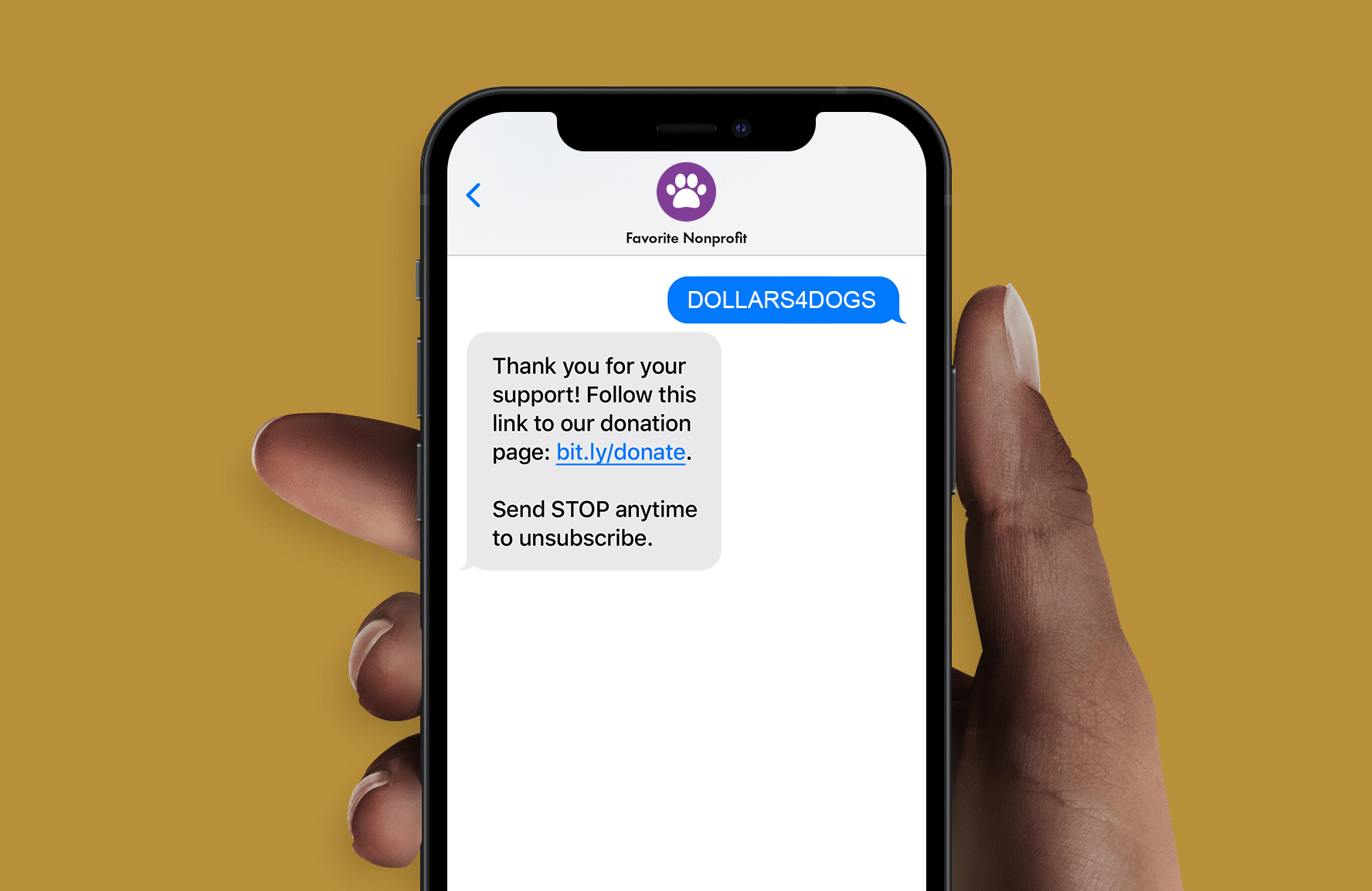
To opt-in to your nonprofit’s texts, donors will start by sending a keyword to a predetermined phone number. When choosing a keyword, keep the following qualities in mind:
- Avoid using spaces or special characters. Most text-to-give platforms make this a requirement, and even if you are allowed to use spaces or symbols, it’s best that you refrain from making your keyword overly complicated. Your keyword should be one word or short phrase that is easy to spell. If your donors have to spend time navigating their keyboards to find a symbol, this may slow down or even frustrate your donors, preventing them from donating altogether.
- Make it relevant to your campaign. Your keyword should be memorable and help donors connect to your campaign. For example, if you’re an animal welfare organization raising funds for shelter dogs, a generic keyword like “DONATE” is not as effective and could apply to any nonprofit organization. Instead, make your keyword specific to reinforce why donors want to give to your campaign, such as “DOLLARS4DOGS.”
- Make it memorable. A catchy keyword is much more likely to attract audiences to your campaign and encourage them to give. Plus, your donors can easily tell others about your campaign and how to sign up for text-to-give if the process is as straightforward as possible.
- Avoid overlapping your keywords between campaigns. If you plan to run multiple text-to-give fundraisers for different projects, each keyword should be unique and used only once. This helps donors avoid confusion and feel confident that they’re donating to the intended fundraising campaign or event.
Make sure your code is relevant to the work your nonprofit is doing. This helps increase the legitimacy of your campaign for donors and makes them feel more comfortable giving to your organization if they know how the funds are being used.
2. Market your SMS campaign widely.
For your nonprofit to grow its text-to-give fundraising efforts, it needs people to opt in. Market your text-to-give number and keyword on the following platforms:
- Email. Send a mass email to all supporters notifying them of your new text-to-give fundraising campaign. You can even segment your emails to different audiences, like major donors, mid-level donors, and new donors, to make your content targeted and more likely to motivate them to sign up. Be sure to emphasize the various benefits of text-to-give for donors, including the convenience of donating right from their mobile devices.
- Your nonprofit’s website. Create a designated page on your website that explains how text-to-give works if you’re running a general, year-round fundraising campaign. You can also advertise this option on your donation page so the next time donors give, they can easily do this right from their mobile devices. If you’re using text-to-give for a fundraising event, feature this giving option prominently on your event landing page.
- Social media. Market your text-to-give fundraiser widely through creative graphics or engaging guides that walk donors through the text-to-give process. For instance, create a video that shows a donor signing up for text-to-give. This will help remove any barriers associated with signing up for a new giving channel and make donors feel comfortable receiving messages from your organization.
If your supporters have any questions or run into technical issues, make sure that your nonprofit has someone available to provide assistance. When you clear up any confusion, your donors will be more likely to trust your organization and eager to support your text-to-give campaign. Once you have a sufficient number of subscribers, your nonprofit can send text messages that appeal to supporters’ emotions, emphasize the importance of their support, and encourage them to give.
3. Make your donation page mobile-friendly.
Donors should be able to easily access your giving page directly from your nonprofit’s text message. It’s therefore critical that you optimize your donation page for mobile devices before beginning your text-to-give fundraising campaign. Your donation page should have the following mobile-friendly features:
- Limited prompts. Collect only the most important information so your donors can complete the donation process as quickly as possible. Ensure that your prompts ask for donors’ names, contact information, donation amounts, and billing information. You can collect any information beyond this later as you develop strong relationships with donors.
- Ample white space. If your donation page looks too cluttered on a mobile screen, donors may get frustrated and abandon the donation process altogether. Ensure that your donation page is responsive to any device size and that each element is reasonably spaced apart.
- Clickable prompts and buttons. Donors should be able to easily tap on the prompts/buttons and enter their information.
- Limited (or if possible, zero) pop-ups. If your donation page has any pop-ups, these can be difficult to exit out of on mobile devices, especially if they take up the entire screen. Avoid using pop-ups, but if they’re necessary, make sure they’re optimized for mobile devices so users can close them out after reading them.
If you’re unsure if your donation page is optimized for mobile devices, run a test by navigating to your website on your phone, or survey donors to get feedback on their mobile experience. If your donation page is difficult to access on a phone, you can optimize it with the help of a web developer or nonprofit content management system (CMS). Many CMS platforms will automatically optimize your entire website, including your giving page, for mobile users.
4. Create inspiring text messages.
To get donors to read your messages and donate to your cause, your messages need to be engaging and highlight the value of giving. Include storytelling elements to explain why it’s important for donors to support your mission.
For example, you can tell a story about a recent project you were able to complete or include a testimonial from someone who benefitted from your nonprofit’s services. Appeal to your donors’ emotions and make them passionate about your cause.
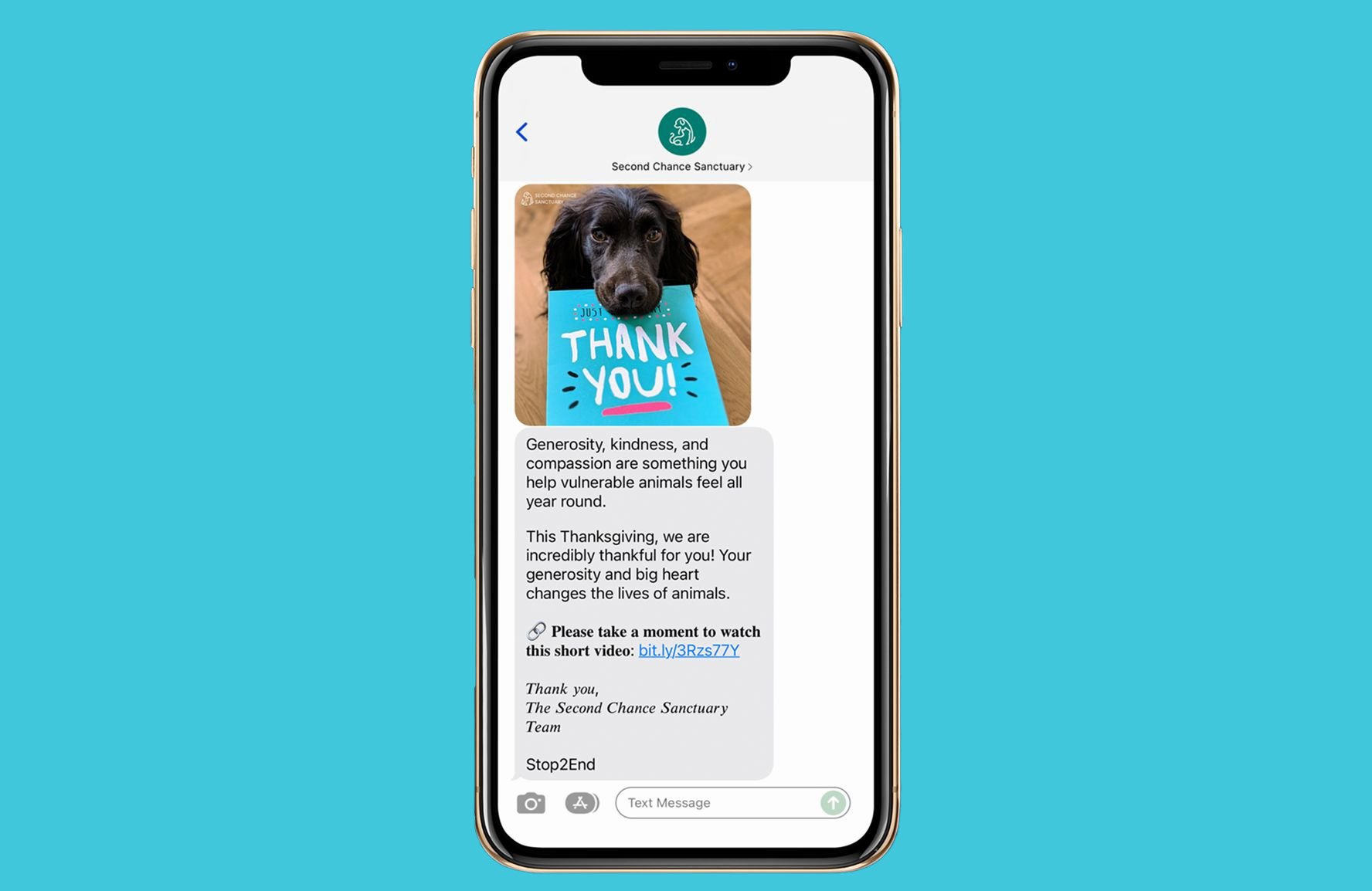
A great way to do this is by including impactful visuals, such as photos or GIFs. For example, if you’re an animal welfare organization, consider featuring a photo of a dog or cat that your nonprofit has directly helped.
Your text should end with a strong call to action that expresses urgency. Use phrases likely to motivate action such as “Donate now!” or “Give today to change lives.” This will push your donors to click on your donation page as soon as they read your text message.
You can also make your donation requests specific, such as asking donors to give as little as $5. While this isn’t a significant amount at first glance, thousands of people donating $5 will quickly add up!
5. Determine the frequency of your messages.
Avoid texting your donors who have opted into your text message campaign too often. This will cause them to unsubscribe from your messages and refrain from donating. However, your nonprofit may be wondering, how many messages are too many? How many messages are too little?
The frequency of your messages will depend on the goal of your text fundraiser, whether it’s for a specific event or an ongoing campaign throughout the year. For example, if your nonprofit is participating in GivingTuesday and only has 24 hours to raise as much money as possible, your organization will likely be sending multiple messages throughout the day. However, if your organization is using text-to-give year-round, you’ll likely only need to send a few text messages each month.
Find a balance by tracking donor engagement and correlating changes in message frequency to unsubscribe and conversion rates. The right text-to-give platform should make it easy to monitor key metrics like these and others. Experiment with the number of communications you send and modify your approach as needed based on how your donors respond. Remember to prioritize quality over quantity when running a text messaging campaign.
6. Collect and analyze donor data.
As you start sending text messages, your nonprofit will receive a lot of new information about existing and new donors. This information will help inform your nonprofit’s understanding of its audience and how it can modify its strategies to maximize support.
Pay attention to important donor information such as:
- Donation amounts. Your nonprofit will likely receive donations of varying amounts from all types of donors. Segment these donors using your text-to-give platform so you can send them targeted communications instead of general donation requests. For example, you can create targeted communications for new donors to steward strong relationships and encourage donor retention.
- Donation frequency. Regulate how often donors are giving to your text-to-give fundraiser. Like donation amount, you can also segment donors according to the frequency at which they give. If you have recurring givers, avoid using the same automated thank-you message every time they give. Get creative and draft different thank-you messages ahead of time to boost donor appreciation.
- Donation recency. If you’re running a year-round text-to-give fundraising campaign, you may experience donor churn or have donors who give only once. Having a record of this information is important because you can create targeted messages to encourage them to give again to your nonprofit. A great way to do this is by highlighting the impact of different gift amounts.
Actively monitor this information throughout your text-to-give fundraiser so you can understand the effectiveness of your messaging and make adjustments as needed. The right text-to-give platform will allow you to find trends in your data and develop an informed strategy to enhance giving.
7. Express donor appreciation
Your donors are the backbone of your organization, and without them, you wouldn’t be able to push your mission forward. To effectively retain their support, you need to text a thank-you message directly after they give.
Use these tips to help your supporters feel valued and encourage them to donate again in the future:
- Personalize your messages: Add a personal touch to your messages by greeting your donor using their first name and referencing the specific donation amount they contributed and the name of the fundraising campaign.
- Describe the impact of their gifts: Your donors may be wondering how their gifts actually make a difference. Explain the tangible connection between their donation amount and how it will advance your mission. For example, you might say “Your donation of $50 will provide meals for ten animals in our care this month!”
- Offer additional engagement opportunities: While you don’t want to immediately ask your donors to give again, you can point them to ways they can continue to stay involved. For example, you might direct them to sign up for your email newsletter, read the latest blog post on your website, or apply to volunteer.
With the right text messaging platform, you can automatically send these thank-you messages right after donors give. This will reduce your team’s administrative burden so you can focus more on strengthening your fundraising strategy.
Tatango: The Top Platform for Text-to-Give
We’ve covered the question: How does text-to-give work? Now, let’s explore the top text messaging platform designed to help your nonprofit maximize its fundraising results: Tatango.
Tatango is the leading nonprofit text messaging provider on the market. Since its founding in 2007, Tatango has helped organizations raise over $500 million for their causes. And, these organizations report an average ROI of 500%, allowing them to connect directly with their supporters and see value year after year.
As a scalable, flexible platform designed to meet the specific needs of nonprofits Tatango comes with the following capabilities:
- Personalization and segmentation tools to customize your messages to various audiences and donor types.
- Automation so you can power off high-impact messages with ease.
- MMS messaging functionality to add valuable visuals, GIFs, emojis, and more that will catch your donors’ eye and inspire giving.
- Administrative control and security so only authorized users can access your campaign data and send messages.
- Powerful integrations so your data can smoothly flow between platforms.
- Advanced reporting capabilities so you can get a bird’s-eye view of how your text-to-give fundraising campaign is performing at any point and make adjustments accordingly.
- World-class support from an experienced and knowledgeable team of SMS fundraising experts.
Backed by an all-in-one nonprofit text messaging platform like Tatango, you can boost your ROI, solidify supporter relationships, and take your organization to new heights.
Partner with Tatango for Nonprofit Text-to-Give
Text-to-give fundraising is one of the best ways to get supporters excited about giving and bring in more revenue for your cause. To seamlessly lead your text messaging campaign, partner with a dynamic text fundraising solution like Tatango.
Recognized as the #1 SMS software for fundraising, Tatango has a proven track record in helping organizations raise millions of dollars for the causes they care about. If you’re interested in maximizing donations and achieving your text-to-give goals, contact us and let our experts help you design a campaign that will increase your ROI.
Eager for more information on how to build and sustain a successful text fundraising campaign? Check out these additional resources:
- An Ultimate Guide to SMS Short Codes: How to Get Started: Learn more about SMS short codes and how the right text messaging provider can walk you through getting your campaign set up.
- Nonprofit Text Messaging: How to Reach Your Audience: Eager for more best practices to run an engaging text messaging campaign? Check out this guide to perfecting your text messaging strategy.
- Text Donation Messages: Examples + Easy Templates: Explore our inspiring roundup of nonprofit text messaging examples to inform your content strategy.

